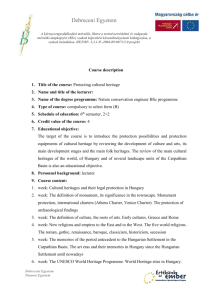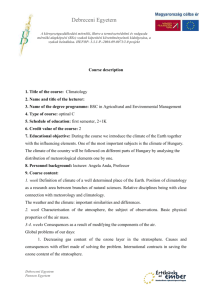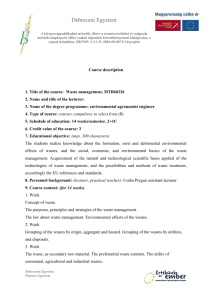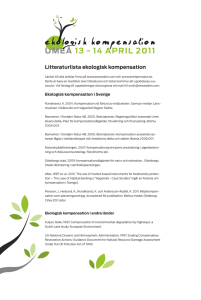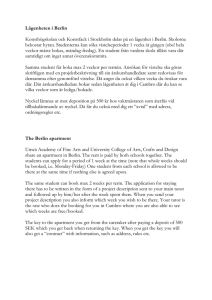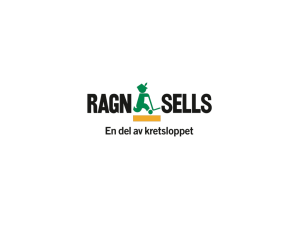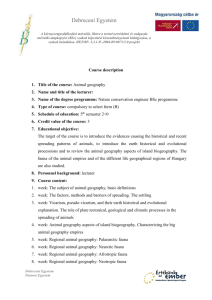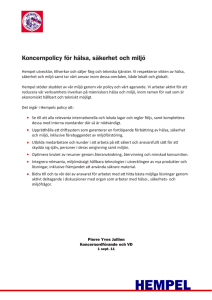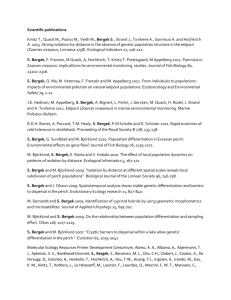Tantárgyi program - Debreceni Egyetem
advertisement
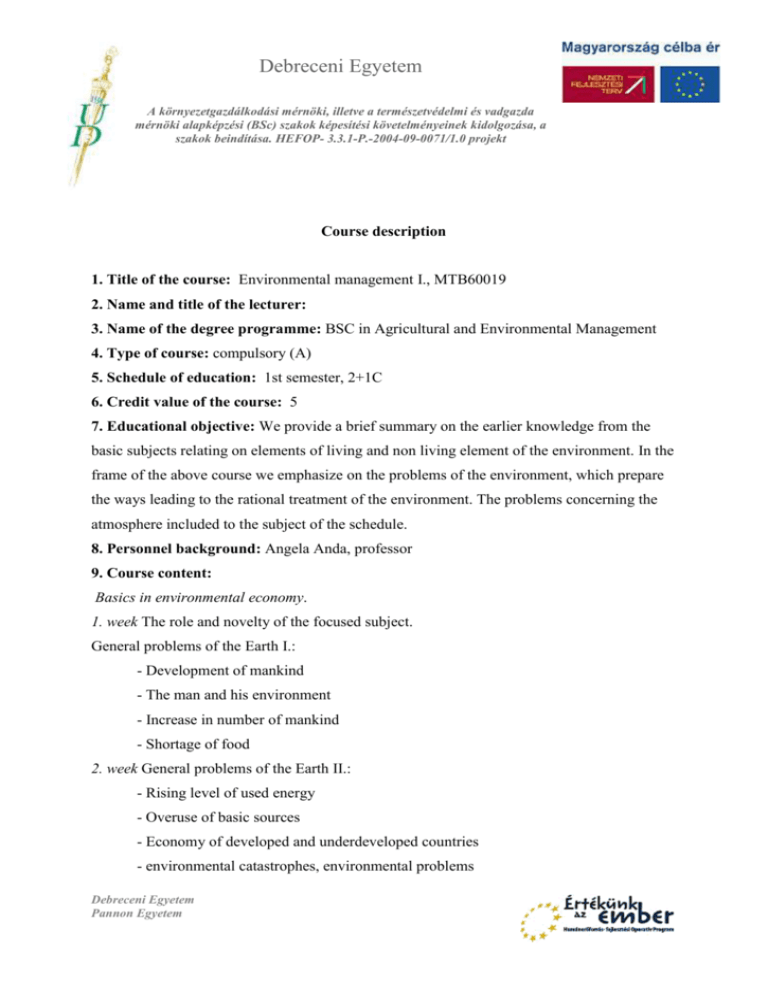
Debreceni Egyetem A környezetgazdálkodási mérnöki, illetve a természetvédelmi és vadgazda mérnöki alapképzési (BSc) szakok képesítési követelményeinek kidolgozása, a szakok beindítása. HEFOP- 3.3.1-P.-2004-09-0071/1.0 projekt Course description 1. Title of the course: Environmental management I., MTB60019 2. Name and title of the lecturer: 3. Name of the degree programme: BSC in Agricultural and Environmental Management 4. Type of course: compulsory (A) 5. Schedule of education: 1st semester, 2+1C 6. Credit value of the course: 5 7. Educational objective: We provide a brief summary on the earlier knowledge from the basic subjects relating on elements of living and non living element of the environment. In the frame of the above course we emphasize on the problems of the environment, which prepare the ways leading to the rational treatment of the environment. The problems concerning the atmosphere included to the subject of the schedule. 8. Personnel background: Angela Anda, professor 9. Course content: Basics in environmental economy. 1. week The role and novelty of the focused subject. General problems of the Earth I.: - Development of mankind - The man and his environment - Increase in number of mankind - Shortage of food 2. week General problems of the Earth II.: - Rising level of used energy - Overuse of basic sources - Economy of developed and underdeveloped countries - environmental catastrophes, environmental problems Debreceni Egyetem Pannon Egyetem Debreceni Egyetem A környezetgazdálkodási mérnöki, illetve a természetvédelmi és vadgazda mérnöki alapképzési (BSc) szakok képesítési követelményeinek kidolgozása, a szakok beindítása. HEFOP- 3.3.1-P.-2004-09-0071/1.0 projekt - contradiction between the society and economy 3. week Definition of the phrase: environmental crisis. The impacts of the crisis. The future of the environment. The Roman Club: Limits to growth. Some suggestion provided to solve the problems. The importance of environmental protection. The conferences organized by the United Nations. 4. week Definitions provided on sustainable development and environmental economics. Giving history of Hungarian environmental protection. The law of LIII (1995). 5. week What do we protect and against what…? The members of environments that should be protected: the Earth, the water, the atmosphere, the living environment, landscape and rural environment. Air quality control 6. week Features of the clean air. Physical properties of the non polluted air mass at surface level. Stratification of the atmosphere. Definition of air pollution and quality protection of the air. The air pollutants, and their groups. 7. week The relationship between the air pollution and weather. Lapse rate and condition of the air (neutral, stable, instable stages). The role of inversion. Dilution and transportation of gases in the atmosphere. The effect of air movement on the fate of pollutants. Vertical movement of air masses. The influence of cyclones and anticyclones on air the pollution level. 8. week The process of air pollution in detailed. Types (local, regional and global scaled) and sources of fair pollution and their characterization. Sources of the emissions (point-, diffuse and line sources, biological sources). Detailed presentation of industrial –with energy sector and transportation- and agricultural sources. 9. week The transmission process. The “Los Angeles” or photochemical smog. Harmfulness of photochemical smog. Debreceni Egyetem Pannon Egyetem Debreceni Egyetem A környezetgazdálkodási mérnöki, illetve a természetvédelmi és vadgazda mérnöki alapképzési (BSc) szakok képesítési követelményeinek kidolgozása, a szakok beindítása. HEFOP- 3.3.1-P.-2004-09-0071/1.0 projekt 10. week Wet- and dry depositions in the atmosphere. The balanced pH of the air and its consequences. The danger of the acid rain. Wet deposition of heavy metals originated from the atmosphere. 11. week Types and evaluation of quantity of emitted pollutants with the Hungarian air quality. The most important gas air pollutants and their origin: - The S-group - The N-group - The C-group (volatile and non volatile C compounds included) Trace gases in the atmosphere with their potential damage (VOC, dioxin etc.). Influences of air pollution in different levels: local, and regional consequences (acid rain). Global environmental problems. Global climate change and depression of the ozone layer in the stratosphere. Wastes, treatment of garbage 12. week Waste materials and their treatments. Definition of garbage together with it’s environmental effects. Groups of the wastes. Tendency in the amount of garbage. 13. week The purpose and basic think of law dealing with treatments of wastes. Treat the wastes. Protection against the increasing amount of wastes. 14. week Decrease in harmful effect of garbage. The re-cycling of wastes for raw materials or energy sources. Way leading to make harmless the non re-usable wastes. 10. Mode of assessment during the semester: two written examination 11. Type of exam: oral examination 12. Compulsory practice related to the course: 4 weeks in summer 13. Compulsory and recommended literature: Budai Sántha, A. 2006. Környezetgazdálkodás. Dialóg Campus, Budapest – Pécs pp. 245. Szlávik, J. 2005. Fenntartható környezet és erőforrásgazdálkodás. KJK KERSZÖV, Budapest Rakonczay, Z. 2005. Környezetvédelem. Szaktudás Kiadóház, Budapest 14. Exam themes: (30 – 60 exam themes in the form of imperative sentences) Debreceni Egyetem Pannon Egyetem Debreceni Egyetem A környezetgazdálkodási mérnöki, illetve a természetvédelmi és vadgazda mérnöki alapképzési (BSc) szakok képesítési követelményeinek kidolgozása, a szakok beindítása. HEFOP- 3.3.1-P.-2004-09-0071/1.0 projekt 1. What is the subject of the environmental economy? 2. Introduce the inter-disciplinarity of the environmental economy! 3. What kind of changes were characteristics before the appearance of the mankind? 4. How did the relationship between the man and its environment changed? 5. What are the global problems of the Earth? 6. Which is the stage of the environmental elements today? What kind of problems arose connecting with the atmosphere, hydrosphere and pedosphere? 7. What is the number of mankind regarding the changing time? 8. What kind of problem arises with increasing number of population? 9. What do you mean on “elder” society? 10. Show the two categories of developing countries with their problems! 11. Show the environmental sources! 12. What kind of crisis does cause by extension use of energy? 13. Sum the activity of Roman Club! 14. What are the consequences of the First World Model? 15. Introduce the results of the Stockholm Conference regarding the policy of the UN! 16. Introduce and analyse the results of the Kyoto Protocol! 17. Show the documents of the Kyoto Protocol! 18. What were the subjects and happening of the World Conference held in Johannesburg? 19. Analyse the environmental policy of the UN! 20. What kind of contradictions are between the society and enterprises? How should be solved this problem? 21. What is the sustainable development? 22. Meet the history of environmental protection with its institutions! 23. Show the subject of environmental protection through the way of introducing the actual law! Debreceni Egyetem Pannon Egyetem Debreceni Egyetem A környezetgazdálkodási mérnöki, illetve a természetvédelmi és vadgazda mérnöki alapképzési (BSc) szakok képesítési követelményeinek kidolgozása, a szakok beindítása. HEFOP- 3.3.1-P.-2004-09-0071/1.0 projekt 24. What are the possibilities of the effective environmental protection? 25. Introduce the types and process of the air pollution! 26. Show the content of the air mass at surface level! 27. What do you mean on the stratification of the atmosphere? 28. Give some examples on weather-air pollution connection! 29. What are the sources of air pollution? 30. The emission. 31. What are the sources of air pollution? What kinds of materials are emitted? 32. Count and characterize the types of air pollution! 33. What is the transmission? 34. Show the wet deposition, the main determiners and influences on the ecosystems! 35. What kinds of pollutant sources are considering the gases? Who are the sources? 36. Show the pollutants from the S group together with the situation of Hungary! 37. Show the pollutants from the N group together with the situation of Hungary! 38. Show the pollutants from the C group together with the situation of Hungary! 39. Show the dust pollution in Hungary! 40. Trace gases of the air as possible air pollutant. 41. What is the PAH and where do it come from? 42. What is dioxin and what kinds of influences it has got? 43. What kinds of processes are to deposit the air pollutants? 44. Recount the effects of local and regional pollutions! 45. Recount the processes of most important global pollutions! 46. Show the influence of global pollutions! 47. Present the damages of dust pollution. Where does it come from? 48. What is the garbage? 49. Classification of garbage. 50. Tell quantitative problems of waste materials! The Hungarian situations. Debreceni Egyetem Pannon Egyetem Debreceni Egyetem A környezetgazdálkodási mérnöki, illetve a természetvédelmi és vadgazda mérnöki alapképzési (BSc) szakok képesítési követelményeinek kidolgozása, a szakok beindítása. HEFOP- 3.3.1-P.-2004-09-0071/1.0 projekt 51. Which is the aim of the law dealing with waste material’s problem? 52. Tell some environmental damages of waste materials! 53. What kinds of methods are known in decreasing the amount of garbage? Which methods do we apply to decrease the damage? 54. Recount methods and advantages of selective collection of wastes! 55. Re-cycling of selectively collected wastes as raw materials or energy sources (compost). 56. Tell the treatments making harmless of non-usable wastes! Debreceni Egyetem Pannon Egyetem
